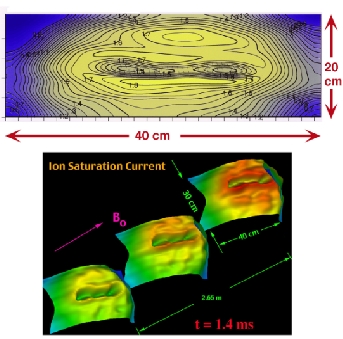|
Studies of electron-ion streaming instabilities will be performed on
the LAPD device by driving strong field-aligned currents. For these
experiments, current densities exceeding the threshold for ion
acoustic (j > n e cs) and Buneman instabilities (j
> n e vth,e) will be necessary. The experiments will use
pulsed grids as well as Barium-oxide coated nickel cathodes which are
brazed directly to ceramic-encapsulated coaxial heating filaments
(Thermocoax) for heating the cathode to thermionic emission
temperature (840-920C). For a 10 centimeter cathode in an LAPD discharge
(Te ~ 10 eV, n ~ 10**12 cm-3), a current of 10A
is required to surpass the ion acoustic threshold and 1kA is required
to surpass the Buneman threshold; both currents are accessible using
standard discharge power supplies and transistor switches. These
thresholds may also be lowered by operating in the cold (Te
~ 1 eV) afterglow plasma. During the experiments, the nature of
fluctuations driven by the field-aligned currents will be
investigated, as well as the generation of anomalous resistivity.
When the threshold for the Buneman instability is exceeded, a search
for and study of electron solitary holes will be performed. In the
Earth's ionosphere and magnetosphere electron solitary holes have
Debye length scale sizes. Velocities of electron solitary holes range
to nearly the electron thermal (or drift) speed.
Gekelman and his group are engaged in experiments with narrow, pulsed
currents and the plasma flows associated with their production. An
example of one of these structures is shown in the figure above). The
intense, pulsed, currents (30A/cm2 ~ vdrift)
have turbulent fluctuations within them and are a likely source of
electron phase space holes. These currents can be enhanced by using
narrow emitting cathodes and collection grids, which we will
manufacture for these experiments.
In the LAPD the Debye length is 16-30 microns. Constructing probes to
measure Debye length structures is a great challenge. In the
preliminary set of experiments, we will use a test chamber associated
with the Large Plasma Device (LAPD) at UCLA. As we develop microprobe
technology the experiments will be moved to the LAPD itself. The test
chamber is 4 meters long and a meter in diameter. It has an
inductively coupled RF plasma source which produced plasmas with
densities below 1011 cm-3. The RF source can be
pulsed at hundreds of Hertz, and the experiments will be done in the
quiescent afterglow plasma when the rf noise from the source is
absent. Apart from this proposal we plan to build a 30 centimeter
diameter cathode in this chamber as a second source. It will produce
a plasma with density similar to the LAPD. The maximum magnetic filed
attainable in the test chamber is 500G. The field will determine the
properties of the currents but, to first order, is not important for
electron hole generation. Since the electron holes are of order of
the Debye length we will first do these experiments in a plasma of
density 1010 cm-3 and Te ~ 0.1 eV in
which case the Debye length is 52 microns. The initial probes we will
use were provided by Prof. Yogesh Gianchandani, and Dr. Jamille Hetke
at the University of Michigan. We propose to design suitable
electronics in collaboration with the UCLA school of engineering.
There are several geometries of the sensor but all contain detectors
which are much smaller than the Debye length, and are spaced 50-100 microns
apart. Since the signals will be small (~ 100 microvolts), amplifiers
will be designed at UCLA if necessary. They will be mounted several
centimeters from the probe tips and will be used to drive miniature
coaxial cables in the probe shaft. Additional amplifiers will be used
outside of the device, and the signals will then be digitized. The
probe survived the plasma environment of LAPD for two days without
damage. The demands on the amplifiers for these probes are non
trivial. This proposal contains funds for fabrication of these
microamplifiers. With twelve fast channels we can study the
propagation of structures as small as the Debye length as well as
their statistical properties. In a controlled laboratory experiment
we can change the plasma density and temperature as well as the
velocity and density of the currents that will be used to produce the
electron holes.
The electron hole research will be led by Gekelman, the director of
the
Basic Plasma Science Facility at UCLA. This work will be done in
collaboration with Troy Carter and Jack Judy (UCLA Dept of Electrical
Engineering) as well as Paul Kintner (Cornell University).
Kintner has participated in many rocket and satellite studies of
the auroral ionosphere and is keenly interested in studying these
structures. He has agreed to participate in analysis of the data and
help us relate the results to measurements in the Earth's
ionosphere. We will make use of tools at the UCLA MEMs center as well
as our relationship with the University of Michigan.
Research Plan
- Year 1: Fabricate small heated nickel cathode and capacitor
bank driver for field-aligned current studies. Perform initial testing
in LAPD test chamber. Design and fabrication of initial miniature
Langmuir probe array and electronics for small scale fluctuation
studies.
- Year 2: Studies of fluctuations and resistivity in
field-aligned current experiments (using standard diagnostic
probes). Initial experiments in LAPD for wider regime. Initial testing
of microprobes and electronics in search for electron hole generation.
- Year 3: Continued studies of field-aligned current driven
instabilities and anomalous resistivity in test chamber and in
LAPD. Iteration on microprobe and associated electronics for
measurement of small scale structures. Design of microwave scattering
system to complement probe studies of Buneman turbulence and
electron solitary holes.
- Years 4-5: Continued studies of field-aligned current driven
instabilities and anomalous resistivity. Fabrication and
implementation of microwave scattering system for studies of Buneman
turbulence and electron solitary holes. Iteration on microprobe and
electronics design for electron-holes studies.
|

